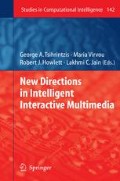Abstract
In this paper, we present and evaluate a new innovative method for quantitative estimation of the musical instrument categories which compose a music piece. The method uses a wavelet-based music source (i.e., musical instrument) separation algorithm and consists of two steps. In the first step, a source separation technique based on wavelet packets is applied to separate the musical instruments which compose a music piece. In the second step, a classification algorithm based on support vector machines is applied to estimate the musical category of each of the musical instruments identified in the first step. The method is evaluated on the publically available Iowa Musical Instrument Database and found to perform quite successfully.
Access this chapter
Tax calculation will be finalised at checkout
Purchases are for personal use only
Preview
Unable to display preview. Download preview PDF.
References
Kostek, B.: Musical instrument classification and duet analysis employing music information retrieval techniques
Kitahara, T., Goto, M., Okuno, H.G.: Pitch-dependent musical instrument identification and its application to musical sound ontology. In: Chung, P.W.H., Hinde, C.J., Ali, M. (eds.) IEA/AIE 2003. LNCS, vol. 2718, pp. 112–122. Springer, Heidelberg (2003)
Martin, K.: Sound-source recognition: A theory and computational mode. PhD thesis, MIT (1999)
Eronen, A., Klapuri, A.: Musical instrument recognition using cepstral coefficients and temporal features 2, II753–II756 (2000)
Eronen, A.: Automatic musical instrument recognition (2001)
Tzanetakis, G.: Musescape: A tool for changing music collections into libraries. In: Proc. Seventh International Symposium on Signal Processing and Its Applications, 2003, vol. 2, pp. 133–136 (2003)
Agostini, G., Longari, M., Pollastri, E.: Musical instrument timbres classification with spectral features
Agostini, G., Longari, M., Pollastri, E.: Musical instrument timbres classification with spectral features. EURASIP J. Appl. Signal Process 2003(1), 5–14 (2003)
Czyzewski, A., Szczerba, M., Kostek, B.: Musical phrase representation and recognition by means of neural networks and rough sets 3100, 254–278 (2004)
Slezak, D., Synak, P., Wieczorkowska, A., Wroblewski, J.: Kdd-based approach to musical instrument sound recognition. In: ISMIR 2002: Proceedings of the 13th International Symposium on Foundations of Intelligent Systems, pp. 28–36. Springer, London (2002)
Wieczorkowska, A., Wroblewski, J., Synak, P., Slezak, D.: Application of temporal descriptors to musical instrument sound recognition. Journal of Intelligent Information Systems 21(1), 71–93 (2003)
Kitahara, T., Goto, M., Komatani, K., Ogata, T., Okuno, H.G.: Musical instrument recognizer “instrogram” and its application to music retrieval based on instrumentation similarity. In: ISM, pp. 265–274. IEEE Computer Society Press, Los Alamitos (2006)
Lampropoulos, A.S., Lampropoulou, P.S., Tsihrintzis, G.A.: Musical genre classification of audio data using source separation techniques. In: Proc. 5th EURASIP Conference on Speech and Image Processing, Multimedia Communications and Services, Smolenice, The Slovak Republic (2005)
Virtanen, T.: Separation of sound sources by convolutive sparse coding. In: Proc. of Workshop on Statistical and Perceptual Audio Processing (SAPA) (2004)
Lampropoulos, A.S., Lampropoulou, P.S., Tsihrintzis, G.A.: Musical genre classification enhanced by source separation techniques. In: Proc. 6th International Conference on Music Information Retrieval, London, UK, pp. 576–581 (2005)
Casey, M.A., Westner, A.: Separation of mixed audio sources by independent subspace analysis. In: International Computer Music Conference (ICMC) (2000)
Smaragdis, P., Brown, J.: Non-negative matrix factorization for polyphonic music transcription. In: IEEE Workshop on Applications of Signal Processing to Audio and Acoustics, 2003 (2003)
Zhang, K., Chan, L.W.: An adaptive method for subband decomposition ica. Neural Comput. 18(1), 191–223 (2006)
Koprivaa, I., Sersic, D.: Wavelet packets approach to blind separation of statistically dependent sources. Neurocomputing (2007) doi:10.1016/j.neucom.2007.04.002
Wickerhauser, M.V.: Adapted wavelet analysis from theory to software. A. K. Peters, Ltd., Natick (1994)
Mallat, S.: A Wavelet Tour of Signal Processing (Wavelet Analysis & Its Applications), 2nd edn. Academic Press, London (1999)
Marchini, J.L., Heaton, C., et al.: The fastica package - fastica algorithms to perform ica and projection pursuit
University of Iowa Musical Instrument Samples Database, http://theremin.music.uiowa.edu/
Martin, K.: Musical instrument identification: A pattern-recognition approach (1998)
Tzanetakis, G., Cook, P.: Musical genre classification of audio signals. IEEE Transactions on Speech and Audio Processing 10(5) (2002)
Author information
Authors and Affiliations
Editor information
Rights and permissions
Copyright information
© 2008 Springer-Verlag Berlin Heidelberg
About this chapter
Cite this chapter
Lampropoulou, P.S., Lampropoulos, A.S., Tsihrintzis, G.A. (2008). Musical Instrument Category Discrimination Using Wavelet-Based Source Separation. In: Tsihrintzis, G.A., Virvou, M., Howlett, R.J., Jain, L.C. (eds) New Directions in Intelligent Interactive Multimedia. Studies in Computational Intelligence, vol 142. Springer, Berlin, Heidelberg. https://doi.org/10.1007/978-3-540-68127-4_13
Download citation
DOI: https://doi.org/10.1007/978-3-540-68127-4_13
Publisher Name: Springer, Berlin, Heidelberg
Print ISBN: 978-3-540-68126-7
Online ISBN: 978-3-540-68127-4
eBook Packages: EngineeringEngineering (R0)

